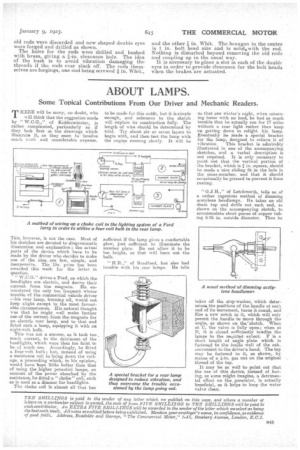ABOUT LAMPS.
Page 31

If you've noticed an error in this article please click here to report it so we can fix it.
Some Topical Contributions From Our Driver and Mechanic Readers.
THERE will he many, no doubt, who will think that the suggestion made by " W.C.G.," of Kidderminster, is rather complicated, particularly so if they look first at the drawings which illustrate it, as they seem to involve much work and considerable expense.
This, however, is not the case. Most of his sketches are devoted to diagrammatic illustration and explanation; the actual parts of the device which have to be made by the driver who decides to make use of ties idea, are few, simple, and inexpensive. The 15s. prize has been awarded this week for the letter in question.
" W.C.G." drives a Ford, on which the headlights are electric, and derive their current from the magneto. He encountered the only to frequent winter trouble of the commercial vehicle driver —his rear lamp, burning oil, would not keep alight except in the most favourable circumstances. His natural thought was that he might, well make further use of the current from the, magneto for an. electric rear lamp, and to thatend fitted such a lamp, equipping it with an eight-volt bulb.
This was not a sucoess, as it, took too much current, to the detriment of the headlights, which were then too faint to be of much use. Accordingly, he fitted a four-volt bulb ; but, instead of using a resistance coil to bring down the voltage, a. proceeding which, in his opinion, would have been little better than that of using the higher potential lamps, on amount of the power absorbed by the resistance, he fitted a "choke' coil, such as is used as a dimmer for headlights.
The choke coil is almost all that has to be made for this outfit, but it is simple enough, and reference to the sketch will explain its construction fully. The length of wire should be determined by trial. Try about six or seven layers to begin with, and then-test the lamp with the engine running slowly. It will be sufficient if the lamp gives a comfortable glow, just sufficient to illuminate the number plate. Do not allow it to be to bright, as that will burn out the bulb.
"-H.R.," of Bradford, has alio:, had trouble with his rear lamps. He tells
us that one winter's night, when returning home with no bad, he had :so much trouble that he actually ran for 17 miles without a rear light rather than keep on getting down to relight his lamp. Eventually he made a special bracket for the lamp, designed to relieve it of vibration. This bracket is admirably illustrated in one of the accompanying sketches, and a verbal description is not required. It is only necessary to point oet that the vertical portion of the bracket, which is e in ,square, should be made a nice sliding fit in the hole in the cross-member, and that it should occasionally be greased to prevent it from rusting.
" G.J.H.," of Letchworth, tells us of a rather ingenious method of dimming acetylene headlamps. He takes an old drain tap and dells out each end, as shown on the accompanying sketch, to accommodate short pieces of copper tubing 516 in. outside diameter. Then he
takes off the atop-washer, which determines the positions of the handle at each end of its movement, turns it round, and files a new notch in it, which will only permit the handle to Move through the angle, as shown on the' sketch. When at C, the valve is fully open; when at D, it is closed sufficiently tosdim the lamps to the reeneed extent. F is a short length of angle plate which is fastened to the inside wall of the cab, convenient to the driver's band. The tap may be fastened to it, as shown, by means of al-in. gas nut on the original thread of the tap.
It may be as well to point out that the use of this device, instead of having, as some might imagine, a detrimental effect on the, generator, is actually beneficial, as it helps to keep the water valve clean.
































